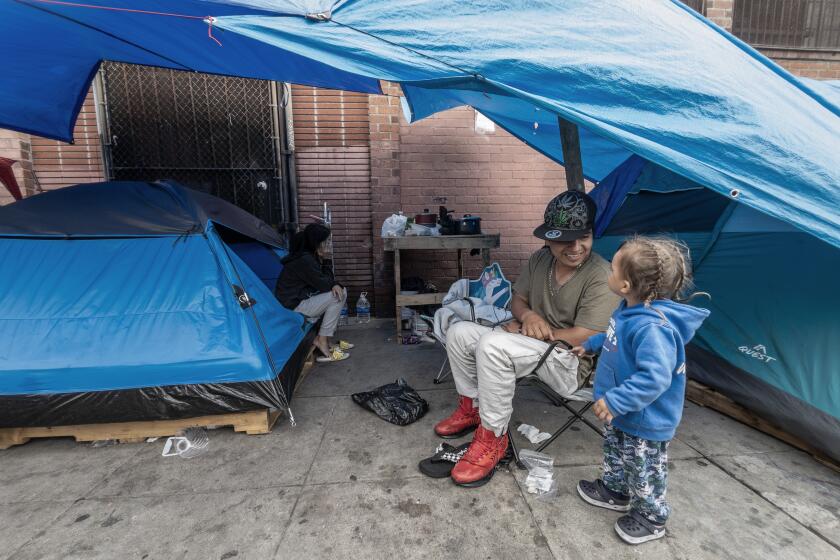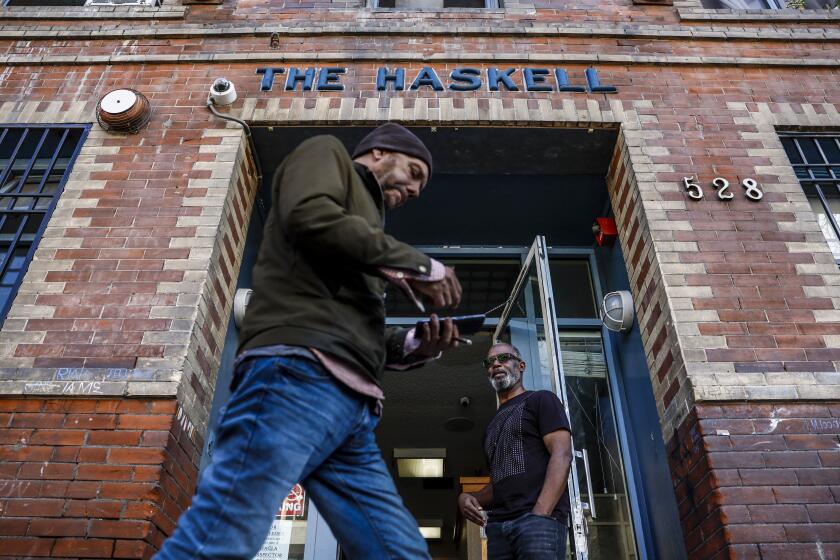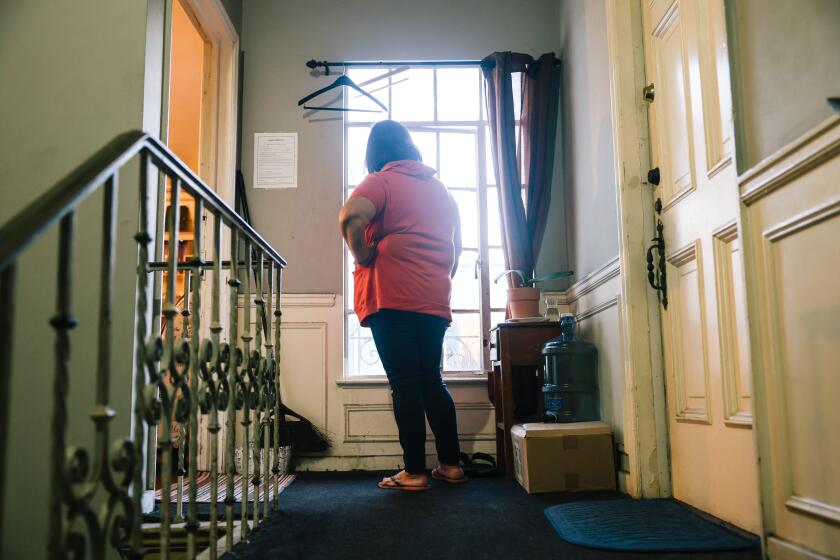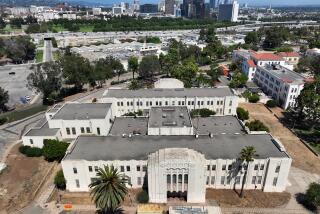L.A.’s accidental homelessness ‘czar’? U.S. District Judge David O. Carter
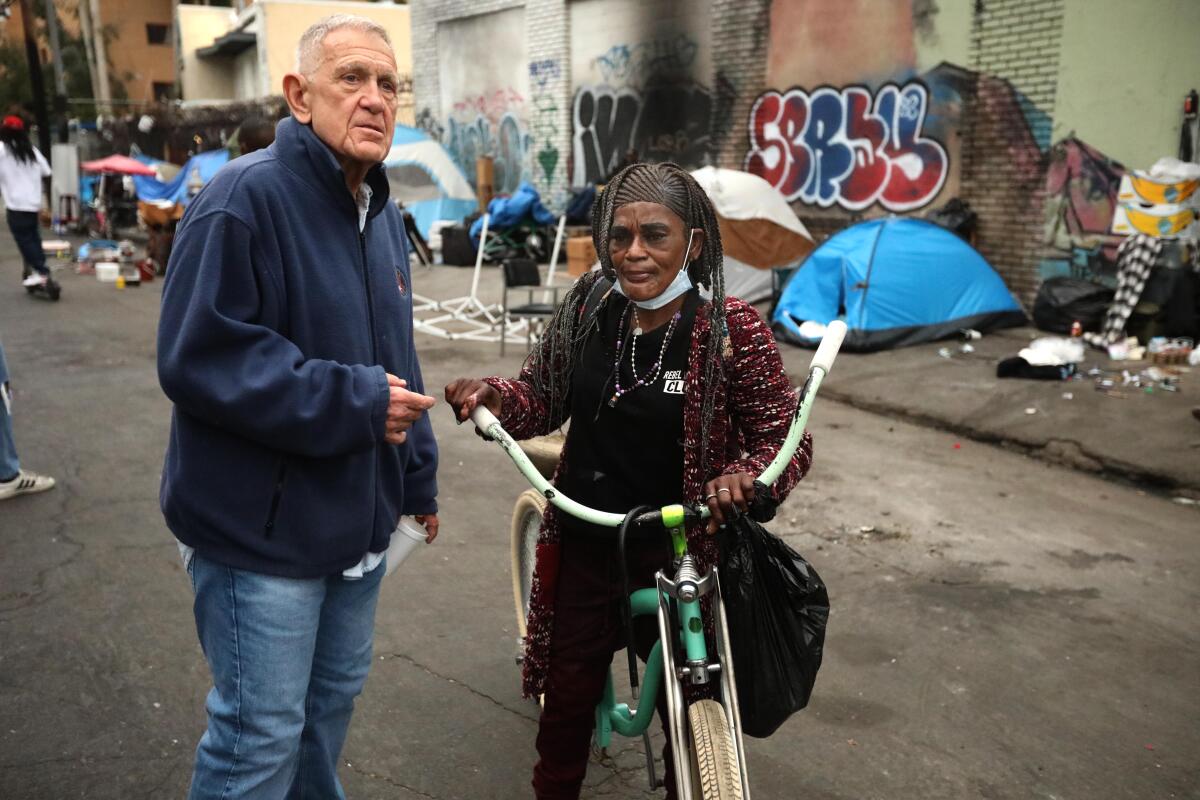
- Share via
It’s an idea that always beguiles but never delivers.
Why can’t L.A. have a homelessness “czar,” a single person with the power to corral and direct the hodgepodge of agencies, as well as bridge the political divides that stymie government’s best intentions?
Mayor Karen Bass has her deputy for homelessness and housing. The county has its Homeless Initiative with its own executive director. Members of the Board of Supervisors and City Council each act as mini-czars, implementing diverse homelessness strategies in their districts. An independent housing authority decides who gets rental subsidies. The joint-powers Los Angeles Homeless Services Authority has its chief executive officer who reports to both the city and county.
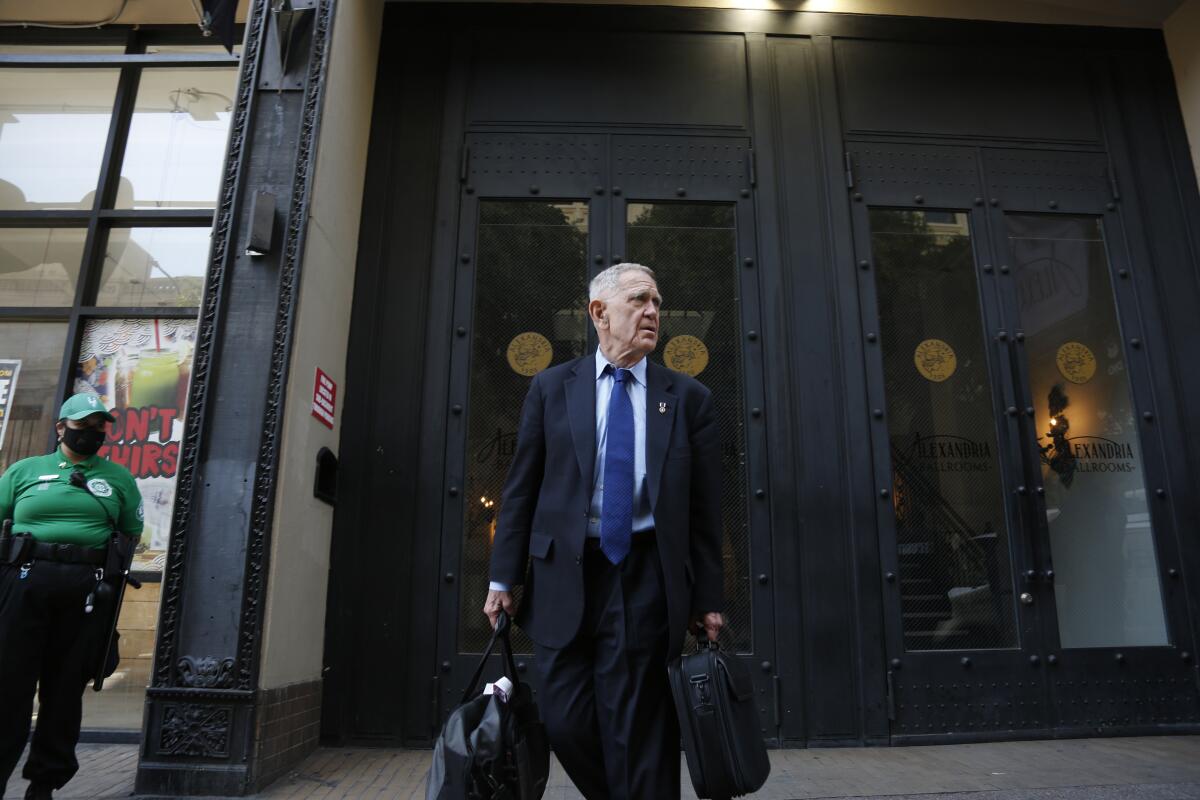
Now a judge has slammed his gavel over all of them. He’s no young upstart but an 80-year-old who projects by word and deed his conviction that homelessness is a moral outrage. Leveraging the powers of federal court, U.S. District Judge David O. Carter has elevated himself, metaphorically speaking, to that position above governmental boundaries that no political leader or bureaucrat can reach.
While overseeing two cases that challenge city, county and U.S. government practices on homelessness, Carter has summoned the mayor, several supervisors, council members and city and county department heads into his courtroom. He’s grilled officials in Washington on speakerphone. And, in moments rich in symbolism, he’s shown more deference in court to Skid Row residents he cultivates as confidants than to the lawyers and public officials appearing before him.
His rulings and, in some instances, merely his bluster have extracted commitments from city and county leaders to produce thousands more shelter beds, provide more treatment for mental health and substance abuse, and is pushing them to hash out an agreement on who pays — in other words to cooperate.
Carter has shaken up a homeless policy long marked by bureaucratic infighting, budgetary battles and competing strategies. But not everyone thinks Carter’s decisions are the best path, and some have chafed over his power to demand change from the perch of his bench.
In his most recent move, motivated by a deep-seated feeling that millions of dollars in homelessness funds aren’t trickling down to homeless people, Carter ordered the city to pay $2.2 million, or more if necessary, for an independent audit of its spending.
And up next, Carter has set an Aug. 6 date for a trial over veterans’ demands that the Department of Veterans Affairs swiftly provide housing for all homeless veterans with serious mental illness or traumatic brain injuries who live in Los Angeles County.
Alternately solicitous and overbearing to the parties before him, flagrantly sloppy with proper names and syntax, but somehow always crystal clear, Carter rebuffed the government’s petition for a dismissal in December backing his ruling with a string of passionate soliloquies.
“We’re the homeless veteran capital of the world right now,” he lectured a phalanx of government lawyers. “So I don’t want to hear excuses about we can’t afford it. It’s the opposite. We can’t afford what’s happening right now, folks. That’s what we can’t afford.”
Carter, a Marine veteran who survived life-threatening injuries in Vietnam, chided the lawyers for a lack of urgency.
“Unless you move, you’re going to lose a whole generation of Vietnam veterans,” he said. “If we stall this out, there’s a whole generation of people in their 70s and 80s who will just pass away without this issue being decided.”
In the last year, there has been a 45% increase in the number of families in L.A. County’s homeless system.
He added a barbed compliment for the secretary of Veterans Affairs, Denis McDonough, who came to L.A. to attend a housing dedication on the VA campus but didn’t accept Carter’s invitation to come to court:
“I thank him for coming out,” Carter said. “But if he came out to dedicate 53 units, maybe he ought to be out here involved in the settlement discussion ... when we’re talking about 4,000 units. I’m looking for that leadership coming from ... the secretary or from this administration.”

In his latest ruling, Carter on May 3 granted class status to the case initially filed on behalf of seven veterans, meaning the VA could be held liable for providing housing for thousands.
Carter’s ascension as “the homeless judge” in Los Angeles came by a quirk. He was assigned the two Los Angeles cases because of his experience in a related case in Orange County, where he is based.
That highly publicized case led to the opening of a 200-bed shelter in Santa Ana and a settlement in which the county agreed to improve conditions in shelters and offer homeless people access to county healthcare and social services before deputy sheriffs could enforce anti-camping and anti-loitering laws.
Carter put his empathy on display, walking through the camps in the Santa Ana River several times, shaking hands, listening to stories and admonishing officials that any eviction must be handled “humanely and with dignity.”
He brought that empathy to Los Angeles with added gusto in 2020 when assigned to a case filed by a group of business owners and residents called the LA Alliance for Human Rights. It alleged that the city and county were neglecting their duty to get homeless people off the streets.
At the height of the COVID-19 pandemic, with the federal courthouse closed, Carter held court in a ballroom of the Alexandria Hotel in Skid Row and began a routine of early morning walks along its streets to personally meet those he saw as at the heart of the case.
Over the years since then, his connection to Skid Row acquired a spiritual tone in court.
“How many people die on the streets every day?” he asked the high-priced consultants who came before him to pitch their qualifications for the audit. It was a rhetorical question designed to impress on them his urgency and his demand that part of their job would be walking the streets with him.
“When you come out of this, you’re not going to be the same person you were — or you don’t have a soul,” he admonished the company that won the contract.
For more than 100 years, single-room occupancy hotels have housed thousands of people in Skid Row. Now, L.A. leaders are saying their time has passed. Some fear losing them will displace their formerly homeless residents.
Carter’s rulings have forced L.A. officials to change policies that long pursued a “Housing First” orthodoxy that disparaged investment in temporary shelter as wasteful.
Early in the case, upon learning of the health hazards associated with living near freeways, he ordered the city and county to move thousands of homeless people out from under freeway overpasses.
Ten days later, then Mayor Eric Garcetti issued an executive order declaring shelter a basic need.
“While the City Council and I continue to implement policies to increase the City’s affordable housing supply, additional emergency shelter beds are immediately required,” it said.
The city and county induced the judge to rescind the order by agreeing to provide housing for 6,700 people with a combination of interim shelter, safe parking sites, rental assistance, family reunifications and permanent housing.
The plan foreshadowed by three years Bass’ more cogent declaration, implemented in her Inside Safe program, that it’s crazy to leave people on the street waiting for housing that might be built years from now.
The passion that Carter exudes has more than once led him to reach too far.
Another judge found he had created the appearance of bias and bumped him off another case after he warned south Orange County cities to “step up” with more shelter or face consequences.
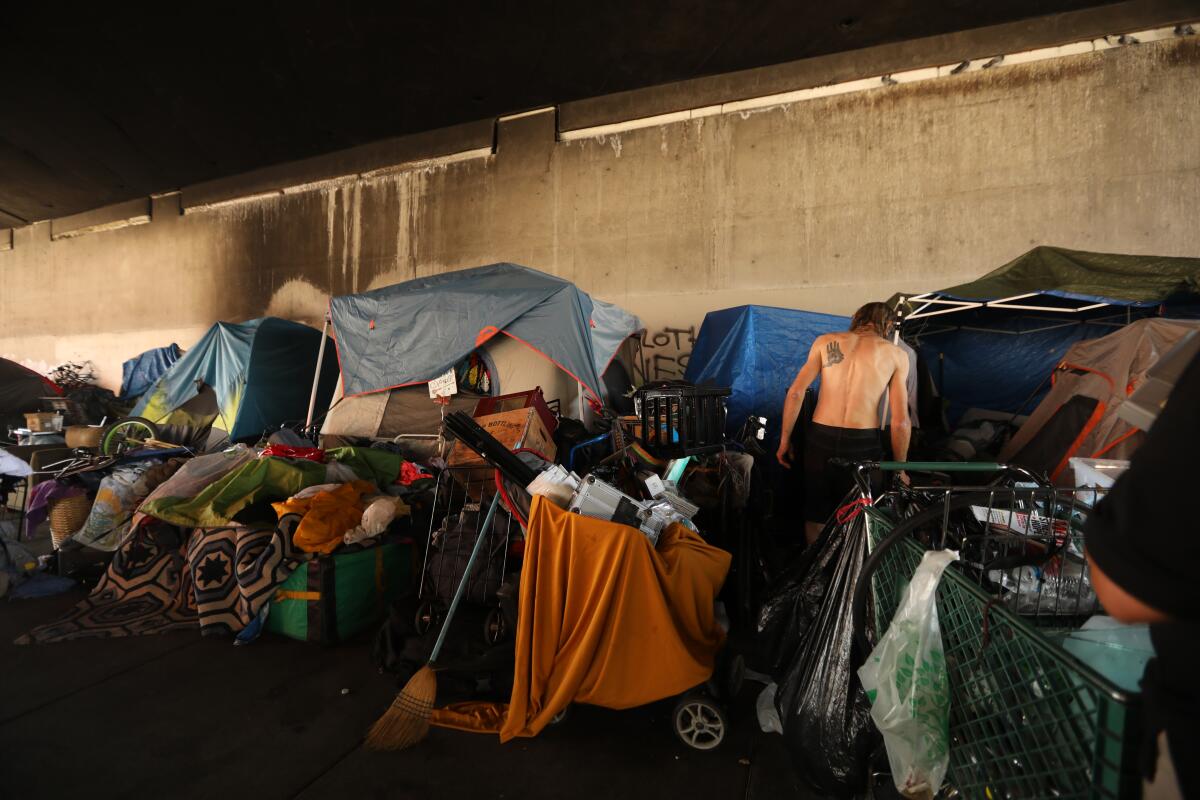
His most audacious move, a 2021 order giving the city and county of Los Angeles 180 days to provide shelter for every unsheltered person in Skid Row, suffered a brutal reversal by the 9th Circuit Court of Appeals.
Carter had poured out his thinking in a 110-page dissertation summarizing the history of anti-Black racism in America and the policy of containing homeless people in Skid Row.
The appellate panel keyed on the judge’s penchant for inserting his own ideas into his decisions, saying he had deployed “novel” legal theories that no one had argued in his court and ruled on claims that no one had alleged and on evidence that was not before him.
“The district court undoubtedly has broad equitable power to remedy legal violations that have contributed to the complex problem of homelessness in Los Angeles,” wrote Judge Jacqueline H. Nguyen. “But that power must be exercised consistent” with the law.
In reality, the myth of the all-powerful “czar” to tackle specific policies — from drugs and terrorism to economic growth to homelessness — is largely a media creation that first took root in FDR’s White House and spread to future administrations and to towns and counties across America.
Mark Ryavec, a onetime legislative analyst to the L.A. City Council and acerbic critic of homelessness orthodoxy, approves of Carter’s method but thinks of him more as a hammer, wielding power in narrow areas, than an all-powerful czar.
“I believe Carter is one of the few bright spots on the horizon, but that he does not have the overall perspective nor power to really turn the situation around,” Ryavec said in an email.
Ryavec provided a list of proposals he said the judge had neither the power nor will to act on: restoring drug referral courts, disbanding the Los Angeles Homeless Services Authority, diverting funds to low-cost shared housing and tackling the high cost of city-financed housing.
The downside of czar-like power, to the extent Carter wields it, is that it is unilateral.
“The judge decides who he wants to listen to and the advice he gets,” said Gary Blasi, a UCLA law professor emeritus who has litigated homelessness issues for decades. “He chooses the advice that seems most consistent with what he thinks should be done.”
Blasi thinks Carter has given too much weight to the LA Alliance, a group whose interest he sees as clearing up encampments.
“It’s about reducing the visibility of homelessness, especially downtown where their interests are,” he said. “It has nothing at all to do with reducing homelessness or making the life of homeless people better.”
Blasi, who was on a team that battled the VA more than a decade ago over the same issues in the current case, is more sanguine about Carter’s manhandling of that giant federal bureaucracy.
“If the problem is you need to hold people’s feet to the fire, that may well be a case where a stern judge with life tenure and the contempt power could be a useful addition,” Blasi said. “I don’t think that describes the situation with our local government here now. I don’t think there is anybody who needs to be prodded to move this issue up to the highest level of priority.”
It is measure of Carter’s determination that he plunges ahead, inured to criticism or reversal.
The Ellis Act has allowed thousands of L.A.’s rent-stabilized units to be taken off the market. A mother and son who fought back want others to know they can too.
A few months after his drubbing by the appeals court, Carter accepted a settlement agreement in which the city committed to creating more than 12,000 additional beds, including both shelter and permanent housing, and removing nearly 10,000 tents, makeshift shelters and vehicles from the streets.
But twice he turned down proposed settlements with the county, demanding more beds for mental health and substance abuse treatment. Having read a report from the former head of the Department of Mental Health that at least 3,000 new beds were needed, Carter insisted on that number.
The LA Alliance and county didn’t get the message, proposing a settlement in October 2022 that provided for only 300 new beds. Carter said no. In April, the parties came back with a bigger number — 1,000. No again.
The parties came back five months later with the number he wanted — 3,000.
With the city’s and county’s settlements both accepted, the case might have appeared to be over. Not so. Carter was only beginning to exercise his power.
In February, lawyers for the LA Alliance asked Carter to sanction the city for slow-walking its promises. He brushed aside a demand for a $6.4-million penalty — later approving $725,000 in legal fees for the firm — but the motion sparked his long-brewing skepticism about how the city was managing its homelessness money.
Even though the sanctions motion did not specifically demand an audit, Carter not only pounced on that idea but segued from it into an almost daily sermon before an audience of senior city and county officials on the need for them to be more transparent.
The crescendo came in the cavernous downtown courtroom with Mayor Karen Bass sitting in the jury box, the city administrative officer and chief legislative analyst and the executive director of the county’s Homeless Initiative huddled in the spectator seats and the chief executive of LAHSA dialed in on the speakerphone.
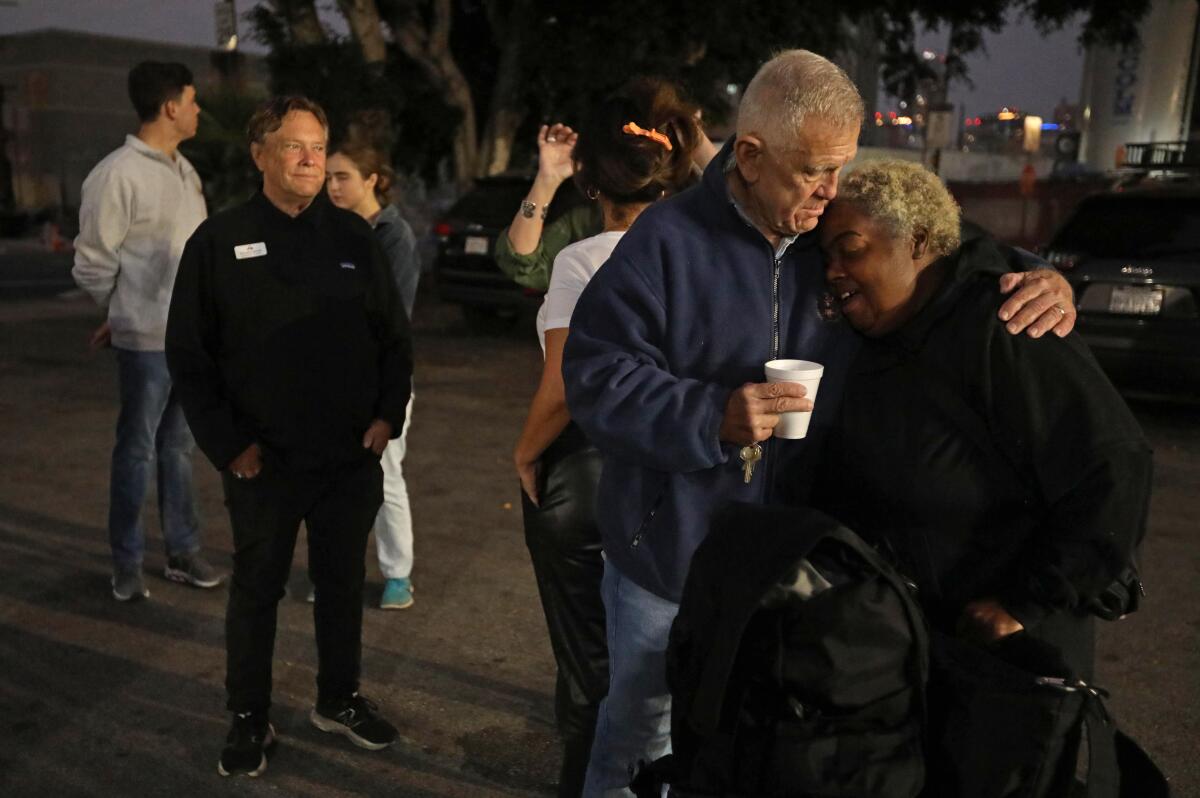
In his characteristic manner, the judge mixed commendation, supplication and insinuation, mangling metaphors and whole sentences in service of cutting insights.
“Mayor Bass, you have this chance as the mayor to be the first entity in this state that steps up with transparency,” he said. “And if you do, I commend you.”
But he was skeptical.
“I anticipate this argument: ‘Judge’— in two weeks quietly I get a phone call ... and the conversation goes this way — ‘Judge, all this money flows through LAHSA ... “But I would suggest to you it might be like punching the Pilsbury Doughboy. As you punch on the city’s behalf, the arm flies up and the finger-pointing starts and we’re back in this convoluted system of trifurcation between city responsibility, county responsibility and LAHSA responsibility.
“But LAHSA in a sense acted as a shield for the city and the county not having responsibility.”
Then he turned to LAHSA head Va Lecia Adams Kellum.
“You’re responsible for much of the provider money. Are you willing or able to make the statement that within two weeks ... that you would require — or I’m sorry, at least send notice to all of your providers that you’re requiring the underlying documentation for the work or alleged work that they’ve performed?”
“Yes,” she said. “We could meet those demands and requests within two weeks to require our providers to have that underlying documentation.”
The case is now settled, but the drama of Carter’s presence in L.A. will continue. By demanding court monitoring, he has assumed oversight of the city and county settlements with the LA Alliance for years to come.
Will L.A. City come through on its commitment to create nearly 18,000 new beds and remove more than 10,000 tents and vehicles from the streets? Will L.A. County get 3,000 new mental health beds up and running?
An 80-year-old-and-counting judge with a strong sense of destiny will be watching.
More to Read
Sign up for Essential California
The most important California stories and recommendations in your inbox every morning.
You may occasionally receive promotional content from the Los Angeles Times.
